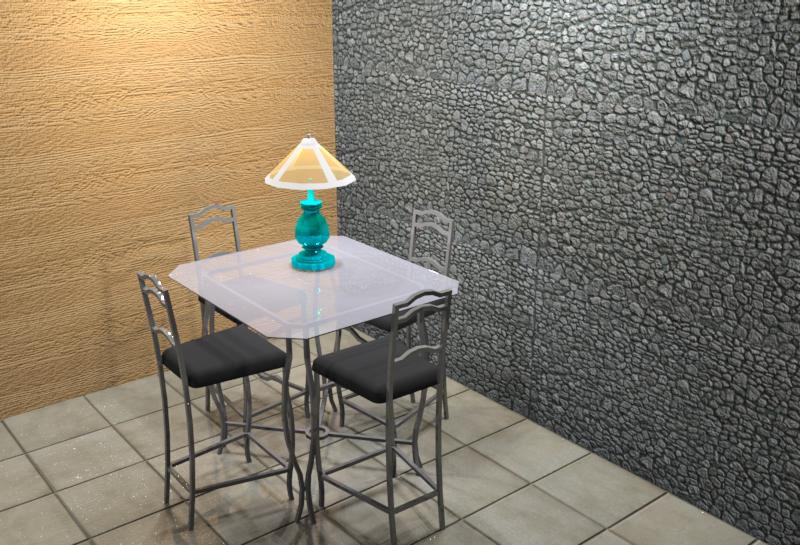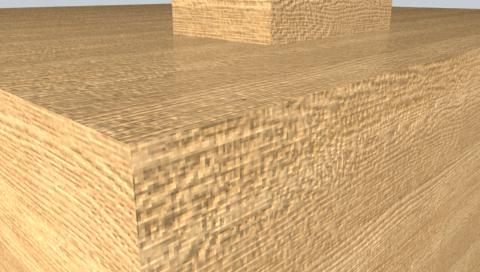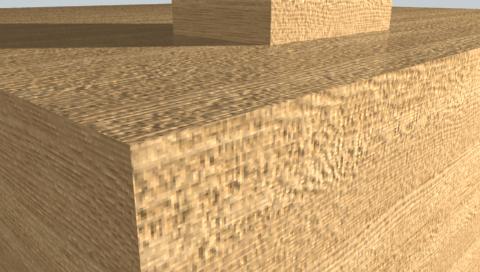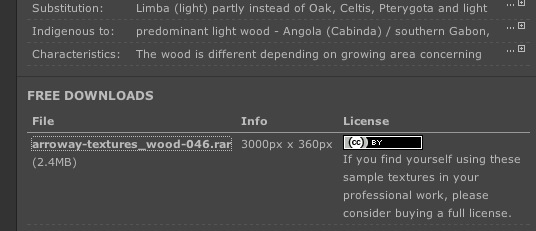Arroway Textures
-
I have been spending time this week working with Arroway textures.
Arroway provides diffuse (normal color), bump, specular and opacity images which can be combined while rendering. They provide medium-res, free, versions of each of their textures in the hopes that you will like them well enough to purchase the hi-res versions.
Here is a simple room with 3 Arroway textures on the walls and floor.
You can see the bump effect easily on the walls, near the ceiling lights. Each material is reflective as well, but that is harder to see without turning it on and off and comparing the images.

-
Note that while the free, low(er) resolution textures are great teasers, they are a bit lower resolution than what would be good for close-ups AND they cannot be used commercially so just careful with where to use them.
They are very nice textures however and my only concern is that I would need one or two from every pack only so I am not purchasing whole packs just for those few because this way they would be a bit pricy.
On another note - they have teamed up with Kerkythea to provide a couple of high-res samples (teasers again) and the Kerky Team turned them into really good Kerkythea materials (you just apply all the necessary shaders with a single click).
-
Hi Al, thanks for the tips on Arroway.
I was thinking about a couple of issues with your renders, do you get to improve them?
I mean does the users here get to see an updated version, which IMHO will make the Arroway textures look more convicing.
-
Seamless? Not really

Com on, use a digital camera, some practice in photoshop or gimp or any other app, that should be enough. And you can share it with your friends.
-
@dspace said:
Hi Al, thanks for the tips on Arroway.
I was thinking about a couple of issues with your renders, do you get to improve them?
I mean does the users here get to see an updated version, which IMHO will make the Arroway textures look more convicing.
Send me some ideas or tips and I will try them if I can, and post new renders here.
-
@gaieus said:
Note that while the free, low(er) resolution textures are great teasers, they are a bit lower resolution than what would be good for close-ups AND they cannot be used commercially so just careful with where to use them.
Their license for the free versions seems to be here: and here. Can you help me find the wording in the license which makes it "non commercial" only?
The do use this phrase in their FAQ "The freely downloadable versions of our textures are mainly intended for testing purposes and private use. Any commercial use is prohibited. Digital redistribution only with proper credits, including a link to our website." But it is not clear if that applies to redistribution of the materials, or images created with the materials.
I will ask them directly I guess.
-
@al hart said:
The do use this phrase in their FAQ "The freely downloadable versions of our textures are mainly intended for testing purposes and private use. Anycommercial use is prohibited. Digital redistribution only with proper credits, including a link to our website." But it is not clear if that applies to redistribution of the materials, or images created with the materials.
Well, in my reading, any here means everykind of commercial use. But I am not a native English speaker so I am willing to be corrected if you guys can interpret this differently.
-
@al hart said:
Send me some ideas or tips and I will try them if I can, and post new renders here.
I was reading a couple of rendering tuts done by you, which I thought was quiet effective, before reading this post.
About improvements, I'm sure you'll figure them out.
Anyway I'll try to give more constructive comments or ideas in future or when I'm more qualified to do so
-
That's cool, Al, thanks.

-
@michaliszissiou said:
Seamless? Not really

Com on, use a digital camera, some practice in photoshop or gimp or any other app, that should be enough. And you can share it with your friends.
Photograph images can work very well. However, in one of our product areas - fabric for office furniture - manufacturers seems to have a very hard time creating good, illuminated and tileable patterns for use with their products through photographic techniques.
What is nice about using well thought bump maps and specular maps is that they can create images where the final result is dependent on both the view angle and the lighting angles. You can (sometimes) photograph materials with illumination and specular highlighting. But these images work best when placed in a model with similar viewing and lighting angles.
Here is an example of a an object with a "lo-res" Arroway texture with the light placed in different positions. You should be able to see subtle differences in the appearance of the texture based on the lighting. (The use of a bump map and a specular map makes it easier to see which direction the light is coming from)


I am not a particular supporter of Arroway. But I have been looking for some good bump map examples for some time and was glad to find that they existed. Some of our clients have chosen to purchase Arroway textures are we wanted to provide a good, one click way to use them. I am aware of at least 4 SketchUp rendering add-ons which support Arroway textures, (Vray, Podium, Kerkythea and IRender nXt - I'm sure there are more), so this isn't really a debate about whether they should be used or not, but an informative thread on what you can do with them.
-
@gaieus said:
They are very nice textures however and my only concern is that I would need one or two from every pack only so I am not purchasing whole packs just for those few because this way they would be a bit pricy.
The have about 50 wood floor textures that can be purchased one at a time for 5 Euros each: One at a time - I wonder why they don't do this for all of them?
-
Yeah, that's exactly what I mean.
Now I don't really use wood floors in my "professional" works - I'd rather see some of the stone textures being sold independently. And one or two of the tiles maybe. -
I noticed this by the download button.

-
@al hart said:
I put the question to Gerald Menzel from Arroway. Hopefully he will clarify it for us.
I got a very favorable response from Arroway:
@unknownuser said:
The information from the FAQs is out of date. Thanks for pointing me to it. I have removed it for revision. Our current policy allows for using the preview versions in commercial renderings.
-
@al hart said:
I put the question to Gerald Menzel from Arroway. Hopefully he will clarify it for us.
I got a very favorable response from Arroway:
@unknownuser said:
The information from the FAQs is out of date. Thanks for pointing me to it. I have removed it for revision. Our current policy allows for using the preview versions in commercial renderings.
(I posted this a second time, because somehow the first one was posted out of order)
-
Thanks Al for the heads-up. Although the preview resolution images are not very high resolution, they are indeed fine for mid and far distance shots.
-
Good to know that they have changed the preview license to allow commercial use.
-
I had our company purchase all of the texture packs about a year ago (I think there's been a new Wood pack since then) and I love them. Prior to that I had actually taken the time to go through nearly every page and download almost all the low res versions. I'd highly recommend picking up the packs if you have some spare coin. The resolution sizes are absolutely huge, some of them are upwards of 10,000x5,000 as I recall. I printed out the PDF catalogs and had them bound so now I just have to flip through the catalog and find the texture I want. Also I've noticed that the bump and specular maps are really well made. It's obvious that they didn't just desaturate the colored image but rather really spent some time to do them correctly.
-Brodie
-
@unknownuser said:
The resolution sizes are absolutely huge, some of them are upwards of 10,000x5,000 as I recall.
That itself would already cause some render applications hard times and memory issues - but of course, choose your tool for the project.
@unknownuser said:
Also I've noticed that the bump and specular maps are really well made. It's obvious that they didn't just desaturate the colored image but rather really spent some time to do them correctly.
That's true. Certainly not some "home made" moonshine.

-
@gaieus said:
@unknownuser said:
The resolution sizes are absolutely huge, some of them are upwards of 10,000x5,000 as I recall.
That itself would already cause some render applications hard times and memory issues - but of course, choose your tool for the project.
We are including an automatic resampling to a width of 1K, 2K, etc. as we create SketchUp and rendering materials from the Arroway textures. We had to do that for our other products since SketchUp users often grab really high-resolution images and place them into models. They look ok for SketchUp, but can really mess up other things like rendering and 3D PDF. (which has to include these huge images in their own 3D model)
That way the user can easily choose a lower resolution if he/she wants to speed things up a bit.
Advertisement








